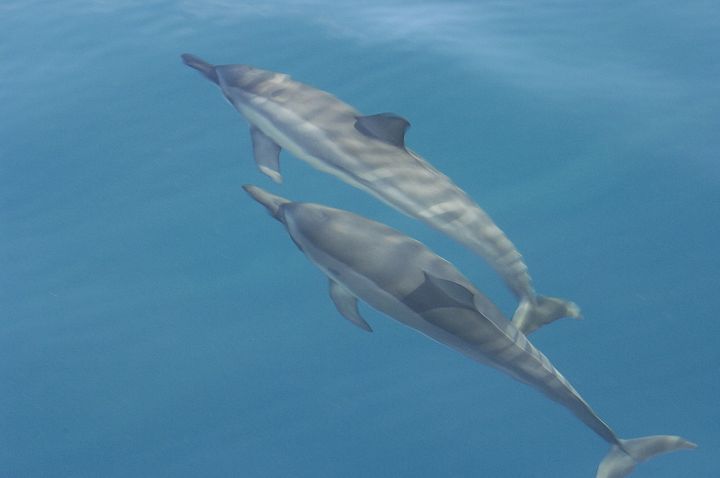
I entered the sapphire, silken ocean water and was suddenly surrounded by dozens of spinner dolphins. They swam in a circle, with me at the center. It was a magical moment. I was on the Hawaiian island of Lanai. My sister, bless her, had treated me to two nights at the plush Four Seasons Resort Hotel after I had just discovered my husband’s infidelity. I did not need to move towards the dolphins—they simply chose to swim around me. Some friends told me that the animals knew I was feeling down and were trying to lift my mood. I was skeptical, but never forgot the experience.
Back in the 1990s, I often had family vacations on Maui. Going to La Perouse Bay to sit on the shore and watch the dolphins was a favorite activity. It is a fairly advanced snorkeling site, so at that time, having young kids in tow, I would not swim there. Despite the fact that there were boats, kayakers and swimmers in the water, seeing dolphins was almost guaranteed. They did not appear to be bothered by all the human activity. In 2004, the authorities decided to ban kayak rental concessions there because of concerns about overuse of the area and resource degradation. It was thought that kayaking was detrimental to dolphins. Locals told me that within weeks of the ban, dolphins appeared in the bay far less frequently. Was this a random correlation or had they decided that the place was no longer an exciting playground?
Many years later, I was snorkeling in the ocean at White Rock in Maui when a group of dolphins raced past me. It took me by surprise and gave me quite a shock. Had I wanted to follow them I would have been out of luck. Even an Olympic swimmer would have been left in the dust. This group had no interest whatsoever in circling around me. It was obvious that if a dolphin did not want to swim with you, there was nothing you could do about it.
Another time I was swimming with a friend at La Perouse Bay and encountered a dozen or so dolphins that were much friendlier. They were clearly slowing down their speed to remain with us. One of the animals was playing with a leaf that was in the water, picking it up in its mouth and then tossing it back and forth to a fin or to its tail, like a kid playing with a ball. After a while, a small tourist boat appeared nearby, and the dolphins sped off towards it. We were no longer the most interesting show in town.
Those who have swum with dolphins in Hawaii often post photos on Facebook, and by doing so they may have helped to trigger moves to make the activity illegal. Some people who have never seen dolphins in the wild have the conviction that swimming with them is always harmful. These beliefs have apparently led to a flood of complaints about swimming with wild dolphins to government agencies, with people criticizing specific activity that they have seen on Facebook.
Human interaction with dolphins is a controversial subject. There is no doubt that human activity around the world has had damaging effects on these marine mammals. The baby dolphin in Argentina that recently died after being taken out of the water and passed around by a mob of sunbathers taking selfies with it sparked international outrage. Over the years, there have been numerous disturbing reports of the ill-treatment of dolphins in captivity, forced to do tricks and “play” with humans. Marine mammals worldwide are threatened by pollution and plastic waste in the oceans. Dolphin feeding from boats, although illegal in the USA, continues to occur, especially in Florida. Wildlife managers in that state reported that between 2002 and 2013, 44 bottlenose dolphins were found stranded with signs of boat-related injuries. Swimming with wild spinner dolphins in Hawaii seems benign in comparison to all these threats.
Nevertheless, the National Oceanic and Atmospheric Administration (NOAA) is currently proposing to ban anyone from approaching within 50 yards of dolphins in Hawaii. As Nick Visser reported in the Huffington Post on August 24, 2016, the Feds believe that the presence of people swimming in their resting areas might make dolphins have to swim further distances to find alternative locations for sleeping. Proponents of the measure claim that interacting with humans drains dolphins’ energy and changes their behavior.
The stated aim of the NOAA proposal is to protect the health and sustainability of the state’s spinner dolphin population. However it appears that fishing operations in Maui may have had a considerably more deleterious effect than swimmers on spinner dolphins. Gill netting has been banned since 2007. However, according to a source on the island, at least as of two years ago, about a dozen companies had bought permits for similar netting operations on Maui. Airplanes are used to spot huge tightly-packed schools of fish in the ocean, known as bait balls, which are then scooped up. I heard that in one day alone, a single operator hauled in 42 tons of bigeye scad, known as akule in Hawaiian. These bait balls of fish are an important food source for dolphins.
Some Hawaiian residents complain that the fishing lobby is extremely strong in Hawaii, making swimmers and tour boats easier targets to clamp restrictions onto. These residents want no additional regulations and insist that criminalizing Hawaii’s dolphin swimmers is a poor use of resources that are already spread thin. The enforcement of existing federal rules to protect marine mammals already challenges cash-strapped government agencies. NOAA is accepting comments from the public on the Hawaii dolphin measure until October 23, 2016.
Government agencies in Hawaii may need to deal with a potentially much greater threat facing Hawaii’s dolphins. In May, scientists reported that the death of a spinner dolphin off the coast of the Big Island of Hawaii last year was caused by a parasite found in cats. It was the first known case of toxoplasmosis in a dolphin for 25 years. This disease, transmitted by cat feces, has already affected the state’s monk seals and nene (Hawaiian Geese). Hawaii’s ballooning population of feral cats—listed globally as one of the most destructive invasive species—now seems to be threatening spinner dolphins. Cats versus dolphins: it will not be a pleasant fight.
Huffington Post Contributor and Former BBC journalist C. J. Grace is the author of the new book Adulterer’s Wife: How to Thrive Whether You Stay or Not, available on Amazon.com. Read C. J.’s blogs on www.adultererswife.com and follow her on Twitter: https://twitter.com/cjgraceauthor.
